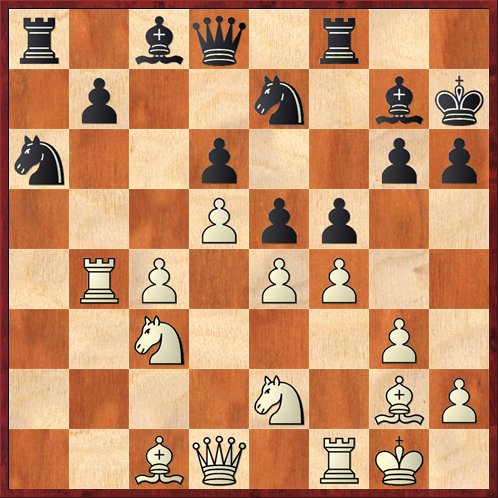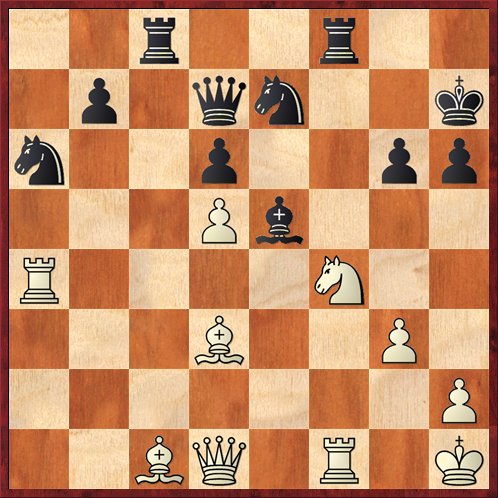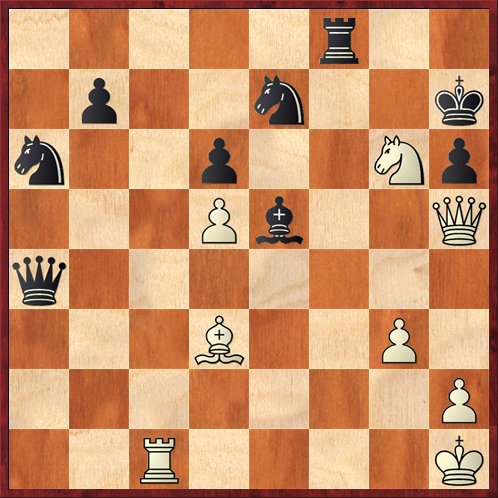One of the most common mistakes in chess, from the beginning level all the way up to accomplished players, is to think that just because you can capture a piece, you should capture it. Perhaps we could call this “the checkers fallacy,” because in checkers you really do have to play a capture if you can. But fortunately the people who devised chess thought better of such a rule, and the game is much more subtle and interesting as a result.
Yesterday, at Mike Splane’s latest chess gathering in San Jose, we saw a good example of this fallacious thinking. It was a game between Jim Bennett (White) and Felix Hernandez-Campos (Black) from the Koltanowski Chess Club last week. Jim is a class-A player and Felix made it to an expert rating earlier this year, but is currently back in class A.
FEN: r1bq1r2/1p2n1bk/n2p2pp/3Ppp2/1RP1PP2/2N3P1/4N1BP/2BQ1RK1 w – – 0 17
Here Jim made a mistake, playing 16. Ra4? instead of 16. Rb1. Here I’m not sure if Jim had really thought enough about why this is a mistake. He just told us, “The computer said that 16. Rb1 is better.” But if you don’t look at the position with your own eyes, you will never learn anything!
The reason 16. Rb1 is better is quite simple. You have to anticipate your opponent’s moves. The move 16. Ra4 gives Black two great moves absolutely for free: … Bd7, developing his last minor piece with a tempo, and … Qb6+, developing the queen with a tempo. Both of these moves would have been impossible or more difficult with the rook on b1.
Felix gladly accepted the two-tempo gambit and played 16. … Bd7 17. Nb5? (also a mistake) Bxb5 18. cb Qb6+ 19. Kh1 (diagram).
FEN: r4r2/1p2n1bk/nq1p2pp/1P1Ppp2/R3PP2/6P1/4N1BP/2BQ1R1K b – – 0 20
Here was where Felix fell into the “checkers fallacy.” My opponent has just blundered his b-pawn, so I should take it, right?
Wrong! The real reason that 18. Nb5 was a blunder was that it weakened White’s center. Instead of capturing a lame pawn that will be difficult for White to defend anyway, Black should increase the pressure with 20. … Nc5, after which White’s center is getting ready to collapse like a house of cards, for example after 21. Rxa8 Rxa8 22. Nc3 fe.
Instead Felix played 20. … Qxb5? and now the momentum shifted back in White’s direction. He played 21. fe! Bxe5 22. ef Nxf5 23. Nf4 Ne7 (White was threatening Nxg6) 24. Be4 Rc8 25. Bd3 Qd7 and now came a move I really liked.
FEN: 2r2r2/1p1qn2k/n2p2pp/3Pb3/R4N2/3B2P1/7P/2BQ1R1K w – – 0 26
How does White keep the attack going?
The answer is 26. Qh5! In some ways this is kind of an obvious move, but it does sacrifice a whole rook and so it requires a certain amount of guts to play it. Jim said that he worked out that he had at least a draw if Black took the rook and maybe more.
Here we had a second, and somewhat ironic, example of the Checkers Fallacy. Obviously Black can take the rook on a4. But should he?
The answer is… yes! According to Jim’s computer, this is the one clear way of forcing the draw. There really isn’t any time to waste for White; Black is threatening to take on f4 next and defang the White attack. And after 26. … Qxa4 White cannot play 27. Nxg6? because of 27. … Rxf1+! 28. Bxf1 Qe4+ followed by mate — for Black! So White has to settle for 27. Bxg6+ Nxg6 28. Qxg6+ Kh8 29. Qxh6+ Kg8 30. Qe6+! (Not 30. Qg6+?, which allows 30. … Bg7) with a draw by repetition.
Instead Felix played 26. … Rxc1??, which loses. I know what Felix was thinking. He was trying to play a deflection sacrifice to lure one of White’s attackers away from the kingside. And he figures that winning a piece is almost as good as winning a whole rook.
The trouble is that the “deflection” is actually good for White! Remember that in the line we just saw, White could not play Nxg6 because of the pin on the f-file. But now there is no pin! So after 26. … Rxc1?? 27. Rxc1 Qxa4 Jim was able to play 28. Nxg6!
FEN: 5r2/1p2n2k/n2p2Np/3Pb2Q/q7/3B2P1/7P/2R4K b – – 0 28
This position is a disaster for Black. Even though he’s a piece up, he has three pieces hanging WITH a discovered check, and of course he can’t capture on g6 because it’s mate in two. To top it all off, White’s rook on c1 (which is only there because Black lured it there) is poised to invade on the back rank. Black was forced to capitulate after 28. … Rf6 29. Nxe7+ Kg7 30. Nf5+ Kf8 (there is nothing really better) 31. Rc8+, with mate next move for White.
I think that this second mistake by Black (26. … Rxc1? instead of 26. … Qxa4) points out a somewhat more sophisticated version of the Checkers Fallacy, which is this: Like any other move, captures have to be played for a reason. Beware of playing a capture “just because it’s there.” The capture 26. … Rxc1 had no reason. It actually helped White. By contrast, 26. … Qxa4 did have a reason. It forced White into making the second-best capture on g6, taking with the bishop instead of the knight, and therefore only drawing instead of winning.
Thanks to Jim for showing us an interesting game!
P.S. I learned something else at Mike’s party that I never knew before. Barry Curto told us that the “Kolty Chess Club” was actually given that name with George Koltanowski’s permission. Barry started the club around 1978 and actually talked with “the dean of American chess” to get his approval for naming the club after him! I don’t know which is more impressive, that or the fact that San Jose has managed to keep the club alive for more than 30 years. (Contrast that with the abject failure of Santa Cruz to keep its chess club going. Maybe we should have named it after somebody?)







{ 3 comments… read them below or add one }
A secondary reason to not capture hanging material is that leaving the material on the board ties your opponent down (OTB, and psychologically) to its defense.
This is a corollary of “the threat is more powerful than the execution.”
Good point! “The threat is more powerful than the execution.” It reminds me of a college story my wife told me. One of her friends played a prank on her in her dorm. My wife told her that she would get her back when she least expected it. My wife never got her back, but her friend was nervous as a result. Jeremy Silman talks about having “bad intentions” when we decide our next move. I think that is important when deciding on a strategy. If we start playing like we play checkers, we get to robotic….”I take, my opponent takes type of thinking.” I need to remember the basic principle of looking for the best move, rather than what appears to be a good move. Thanks for the post Ashish and Dana.
Capture in chess must be connected to board position and also flows to one’s overall strategy..but when you are playing over the board sometimes its hard to find the best move whether to capture it or not..and you are psychologically disturbed.like ex world champion mikhail tal,he makes sacrifice ,and you loose.then when you analyze it back home..what the?..its unsound sacrifice..then kasparov came and make force varition,..capturing it or not you still loose..thats why grandmaster or world champion still loose even if they reached the highest rank in chess..chess is one of the masterpieces of human inventions